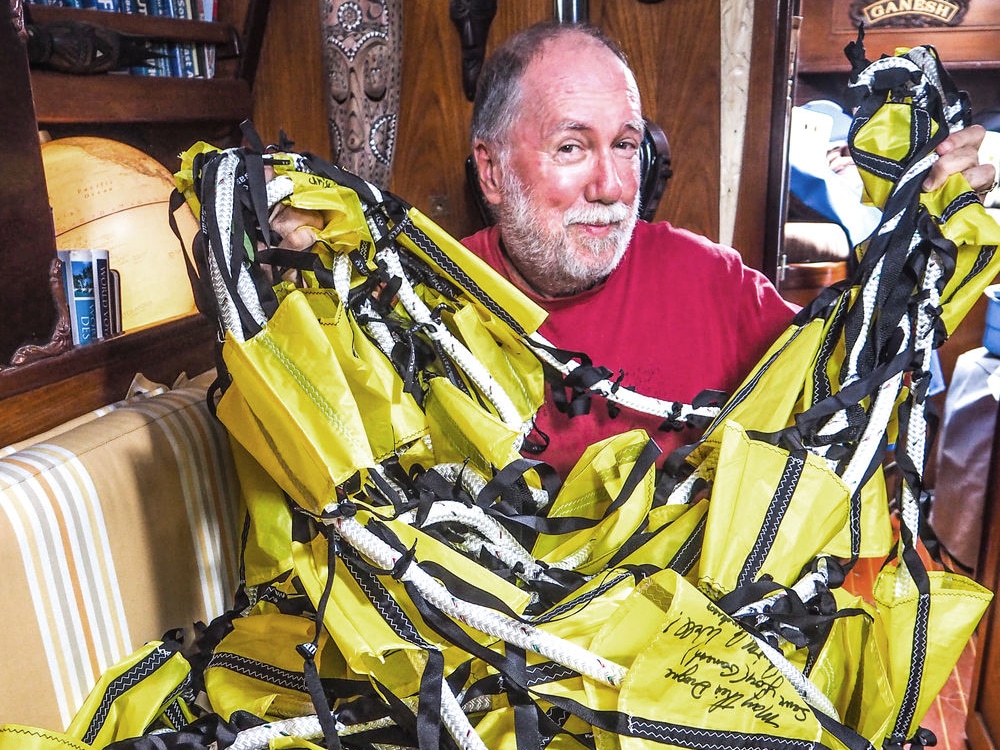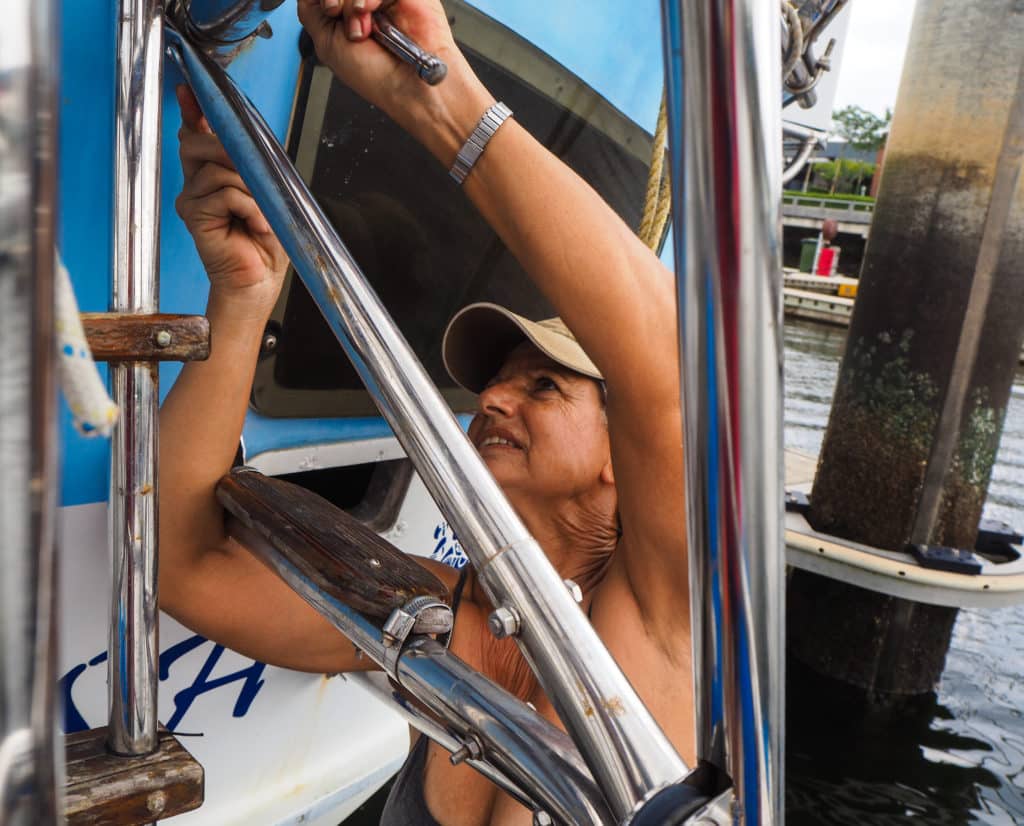
By the time most American and European circumnavigators stare out across the Indian Ocean, they’ve already transited the largest, widest ocean in the world. They’ve also sailed halfway around our watery planet. Even more impressive, they’ve traveled down to windy New Zealand, been blown through the howling Torres Strait, and have waved at the nearby Roaring 40s and the Southern Ocean. Most have numerous gales under their belts. Thus they’re susceptible to a bit of a swagger. They figure they’re ready for anything.
They’re not.
The Indian, as we call it, is an ocean unto its own. Nobody ever considered calling it pacific. Sure, the Atlantic can kick up a bit, but that’s in winter. On some level, it’s always winter in the Indian. It seems each time I’ve voyaged through this patch of roiled water, things have gotten weird. A number of times we’ve been sailing along with moderate but blustery conditions, a fixed wind speed, a steady barometer and a clear sky, and then all hell has broken loose. It is hard to say why conditions go from fresh to fearsome so quickly. Some say the bottom topography causes mysterious upwellings that dramatically affect the sea state. Others blame it on colliding ocean currents, with stray meanders of the Agulhas and East Equatorial clashing unseen beneath you. I am not a scientist. I cannot say. What I can tell you is that the Indian gets angry. It is as if the ocean itself becomes bulling and aggressive.
Yes, I have respect for the Atlantic. Sure, I don’t take the Pacific lightly. But I approach the Indian with true trepidation. The closer you get to South Africa, the more irritable she becomes. Most boats lost in the Pacific are as a result of navigational laxness. They are sailing along and hit one of those pesky low-lying isles like the Tuamotus. The Indian Ocean isn’t so kind. She doesn’t allow you to wearily row from reef to shore. Instead she literally shakes boats to bits in deep ocean. This season, by the reckoning of the transiting fleet leaders, 5 percent of the cruising fleet leaving Southeast Asia and Australia didn’t make it, being either forced to retire with severe damage or sunk.
Gulp!
Bear in mind that these sailors and their seasoned craft are the best of the best, not that it matters to the Indian. My point is this: Nobody who has ever transited this ocean takes it lightly. Thus, Carolyn and I worked very hard for almost three months to prepare.
One of the first things I did was attempt to get in sync with the ocean itself. I did this first in the old-fashioned way, by peering at my worldwide Pilot Charts for historical wind and swell data. Next I followed the transiting vessels on my SSB radio. Third and most surprisingly, I monitored a top-secret Facebook page.
That’s right, top-secret and by invitation only. Why? Because of the Somali pirates to the north. Paranoia gets thoroughly mixed with reasonable caution in the Indian, until you’re never quite sure what is prudent, what is paranoia, and what is just plain nutso.
Regardless, someone transiting has to vouch for you before the Facebook administrator ashore will send you the password. I’m not even allowed to mention the name of this (occasionally silly but also highly useful) Facebook group.
Heavy sigh. What would Joshua Slocum say?
In my research, one thing was apparent: It was a particularly rough year. Many South African sailors returning home, who had done this passage many times, were given a “good thrashing,” as one put it. These guys are tough. Anything that makes a Cape Town sailor frown would make me burst into tears, scream “Mommy! Mommy!” and call the U.S. Coast Guard for a helicopter.
Carolyn, of course, has other priorities. She is not only my wife, lover, best friend and first mate of 46 years, but also our ship’s seamstress. In addition, she has another title: Mistress of the Drogues. A few months ago, she inspected our Para-Tech sea anchor, our slowing drogue made from webbing, our self-designed experimental Fat Flat drogue, and our Jordan Series drogue. Why so many? Because they do different things under different conditions at different times.
Most of the time we deal with gales simply by heaving to. However, a number of things (sails, track, sheets, blocks, rudders, rig, etc.) have to function properly to effectively heave to in 40-plus knots. This is where our quiver of slowing drogues comes in. They act as backup.
If there is a lee shore and I desire minimal drift, I toss a parachute-type sea anchor off my bow. This is easy to deploy while heaved to but hellaciously dangerous to retrieve.
If I want to continue moving downwind (for instance, to escape the storm track or close with my destination), I toss over the Jordan drogue from my stern, with perhaps just a scrap of sail up to dampen my roll. Nice! (Though you get pooped often and your rudder is in considerable danger this way, there’s no such thing as a free lunch, especially off the Cape of Storms.)
Our other drogues are just smaller slowing drogues. The term “slowing drogue” can be a bit of a misnomer, as one helps us make better daily runs in heavy weather by reducing any tendency to round up and eliminating any possibility of pitch-poling. Thus our Monitor self-steering vane can steer far longer in truly gnarly conditions.
While Carolyn had her ancient bilge-scented Pfaff sewing machine out, she whipped us up yet another version of the Fat Flat drogue — basically an experimental Jordan-style device that’s cheaper and stows more compactly.
Carolyn’s seamstress duties don’t stop with the drogues, however. She happily sewed my McMurdo Smartfind S20 pouch to my safety harness. (If I fall overboard, an AIS alarm aboard Ganesh immediately rings and Carolyn will be able to, hopefully, return to my position.)
Yes, I am a big believer in AIS, which is increasingly required in many countries, such as Singapore and Thailand. So for this crossing, I updated my Vesper Marine WatchMate 850 to a WatchMate Vision, which even displays via Wi-Fi directly on our iPad charts.
Since Singapore and South Africa are both so heavily transited by commercial traffic, I also swapped out my old dysfunctional radar for a new Furuno wireless. (It is not really wireless, since it requires a power cord, but it is wireless in the sense that it reads out on both our nav-station iPad and our helm iPad.)

Next up was a major project: fiberglassing an easily opened drain onto my Aqua Lift-style muffler so if I roll 90 degrees or more to starboard, no water can gurgle into the cylinder head of my Perkins engine. (Heeling sharply to port isn’t a problem for Ganesh.)
This wasn’t fun. Trust me: Grinding fiberglass in a small, poorly ventilated space while directly on the equator is a pain. But the difference between cruisers and dreamers is that the cruisers do what needs to be done, no matter how onerous the task.
Next, I gave our storm trysail its annual inspection, as well as made sure our life raft and related gear were all set. We not only carry a hand-operated desalinator but also an AIS man-overboard device, a waterproof handheld VHF, and a strobe that can be hoisted on a box kite (all powered with solar rechargeable batteries). Excessive? Perhaps. Some would say I don’t need the Ocean Safety life raft aft, since I have an upside-down (triple-lashed) inflatable on the foredeck, as well as a second Viking raft down below, but, hey, just because I’m one of the lowest-cost vessels transiting the Indian Ocean this year doesn’t mean I can’t be the best prepared.
Better safe than sorry.
Our genoa was almost 20 years old. We had restitched it numerous times. So when I bumped into Phil, an eager young Kiwi sailmaker in Langkawi, Malaysia, I ordered a new one.
Then, continuing preparations, I noticed some excessive movement at the forward edge of our hard dodger and added four stainless-steel braces to eliminate it.
Needless to say, I did our mandatory just-before-a-major-crossing rig inspection armed with a magnifying glass. I felt every inch of our stainless-steel rigging wire. (It is much easier to spot strand cracks with your hand than with your eye.)
Since heavy weather dramatically increases the chance of fire offshore, I looked at our fire extinguishers. I also inspected our propane system from tank to flame. Darn it. At the last minute, I realized that the at-rest voltage of my starter batteries wasn’t what it should be. So I lugged four new batteries aboard to ensure we could crank up even if our house bank was somehow flattened. Just to gild the lily, I added a seventh solar cell and a new regulator dedicated solely to the starting group. Whew!
Yes, all of our regular running lights were functioning, as well as our low-draw superbright LED tricolor.
Next up was some TLC for our Perkins diesel: new primary and secondary filters, impeller, exhaust flange, and transmission filter. Plus, of course, all the usual fluids were replaced and the air-purifier filter was inspected. I also checked our engine maintenance log and discovered it was time to renew our extended life coolant.
Meanwhile, Carolyn was still at work. She was sewing up an additional spray dodger, which we’d custom-fitted to the midhatch so we could keep it open longer in difficult yet tropical conditions.
“Don’t forget we’ll have to dig out the winter clothes,” she reminded me. “Remember last time how chilly we were in Cape Town?” Drat! I’d forgotten.
“Do we still have our sea boots?” I asked. She shook her head negatively. After so many years on the equator, I’d spaced out on such cold-weather details.
While I was inspecting the rig, I replaced our VHF antennas and added some modern LED spreader lights — oh, and a loud horn with numerous strobes that are wired into our burglar (and panic button) system.
Panic button? Yeah. Alongside my bunk is a button I can push, connected to a relay that turns on my siren alarms, strobes, horns and spreader lights. The idea is to scare away any unwelcome boarders while they are still outside on deck, rather than be awoken by them right next to me, with machetes in their upraised hands. (Yes, if anyone steps into our cockpit at night, the burglar alarm rings, but I can actuate the panic button if I hear swimmers or feel another vessel bump us.)
Next we renewed the weatherproofing around our cockpit locker and generally inspected our entire boat for watertightness during a roll. (Batteries, stove and sole panels locked in place — check!) Of the seven yachties I know who have rolled, four of them were severely injured by loose but heavy UFOs winging around the cabin. Thus we’re careful with our storage, and we have storm plugs for all our dorades.
We re-greased all the winches and replaced two sheets and one halyard. Ditto all the control lines and high-tech blocks on our Monitor windvane. Actually, there was far more prep work than all I’ve mentioned here, but space compels me to close. You get the idea. After all this work, we tied up to a dock next to a Malaysian restaurant to await being hauled out. A dockside landlubber with his girlfriend pointed to us and said: “Look at that — retired and lying around their yacht all day. That’s the life!”
“You betcha,” I replied, lazily grinning back. “We ain’t done nothing since, like, the 1960s, when we met during the Summer of Love!”
Fatty and Carolyn are currently on passage toward Africa, counting their calluses along the way. Their latest book is Storm Proofing Your Boat, Gear, and Crew.








